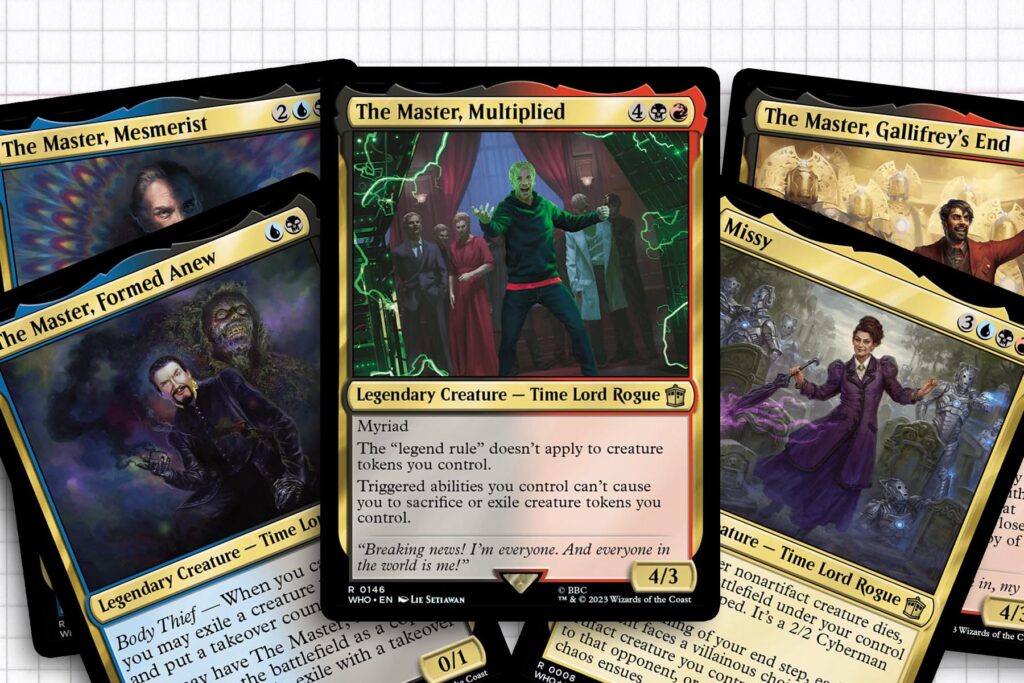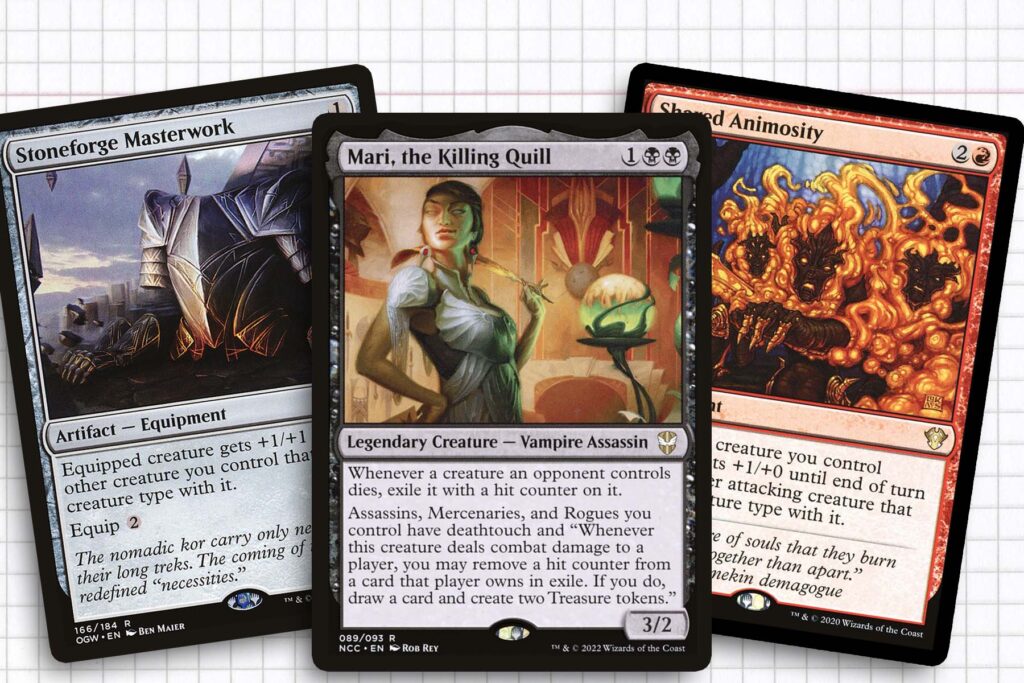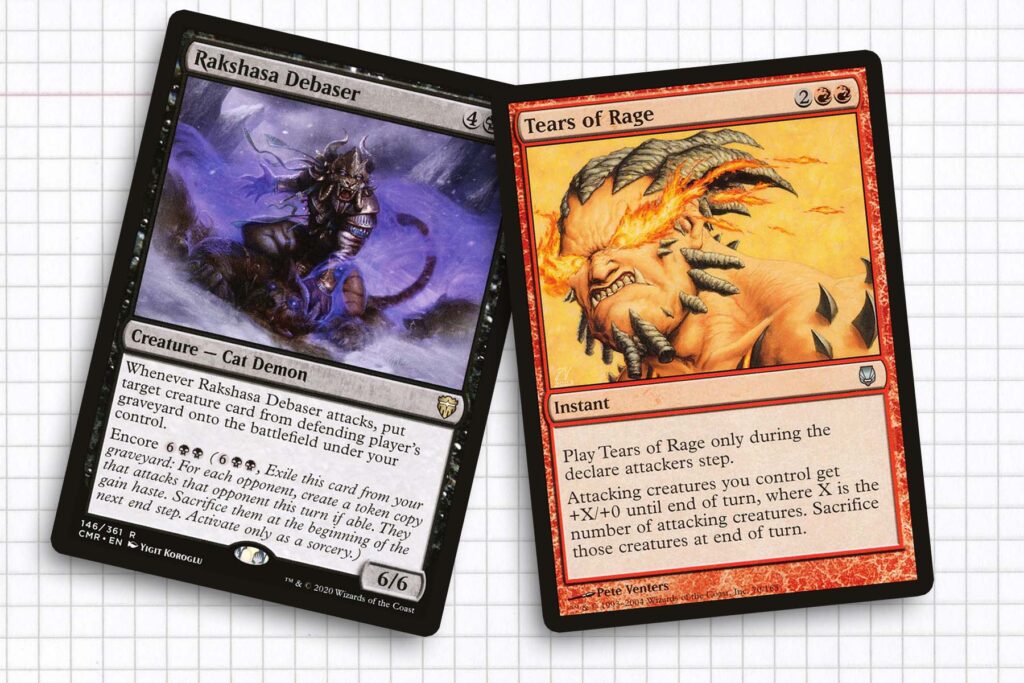The Doctor Who Universes Beyond cards have been a wellspring of inspiration ever since we got the first big wave of preview cards at the beginning of the month. Alas, with everything moving so quickly, I did not have time to focus on each legendary creature with the time and attention I would have liked to. With that said, I was critical of myself for not seeing just how diverse the card designs were for the character of The Master. And while I will not be trying to construct a deck involving all of their incarnations, I did want to focus on the one which stood out to me the most as being fertile ground for an interesting new deck I feel can take a lot of cards from Magic’s history, The Master, Multiplied, and utilize them in a way that we haven’t really seen possible before.
Constructing this deck required me to reign in my own expectations of accomplishing this hybrid of go-wide and Voltron deck, and allow myself to lean in the direction of a more straightforward interpretation of the card. In the end, we tap into some hidden gems en route to creating the blueprint for a deck I really think is going to become something I will want to return to in the future. Let’s look at the deck, talk about the lore, and get into my thought process for how we make The Master multiply.
Commander
Creatures
- Ardoz, Cobbler of War
- Delina, Wild Mage
- Devilish Valet
- Duplicant
- Feldon of the Third Path
- Flamerush Rider
- Instigator Gang
- Mari, the Killing Quill
- Nadier’s Nightblade
- Oona’s Blackguard
- Pitiless Plunderer
- Rakshasa Debaser
- Rose Room Treasurer
- Ruthless Technomancer
- Skyline Despot
- Solemn Doomguide
- Vampire Cutthroat
- Viscera Seer
Artifacts
- Arcane Signet
- Blade of Selves
- Charcoal Diamond
- Decanter of Endless Water
- Dolmen Gate
- Fire Diamond
- God-Pharaoh’s Gift
- Lightning Greaves
- Maskwood Nexus
- Masterwork of Ingenuity
- Mimic Vat
- Sol Ring
- Stoneforge Masterwork
- Talisman of Indulgence
- Thought Vessel
- Wayfarer’s Bauble
- Zephyr Boots
Enchantments
- Conspiracy
- Cover of Darkness
- Dark Prophecy
- Determined Iteration
- Dragon Shadow
- Feast on the Fallen
- Fervor
- Haunted One
- Hazoret’s Favor
- Mana Echoes
- Shared Animosity
- Splinter Twin
- Uncivil Unrest
- Unspeakable Symbol
- Warstorm Surge
Instants
- Dark Ritual
- Nasty End
- Plumb the Forbidden
- Tears of Rage
- Village Rites
- Sorceries: Crippling Fear
- Damnation
- Ghired’s Belligerence
- Heat Shimmer
- Kindred Charge
- Kindred Dominance
- Spiteful Repossession
- Twinflame
Lands
- 11 Mountain
- 9 Swamp
- Barren Moor
- Blasted Landscape
- Blightstep Pathway
- Bloodfell Caves
- Canyon Slough
- Command Tower
- Dragonskull Summit
- Drossforge Bridge
- Forgotten Cave
- Geothermal Bog
- Haunted Ridge
- Luxury Suite
- Polluted Mire
- Smoldering Crater
- Sulfurous Mire
- Temple of Malice

The Many Lives of A Renegade
First appearing in the 1971 story “Terror of the Autons,” The Master is easy to equate them to a James Moriarty to The Doctor’s Sherlock Holmes. But in thinking it over, I don’t know if it’s an accurate description. As contrived as it might be, The Master is more akin to Batman’s Joker, but in the way that The Doctor and The Master can often be seen as a mirrored pair. Both are renegades of the Time Lords, but The Doctor’s sense of order and empathy for the residents of the universe is contrasted by the chaotic Master, who sees most species as a means to an end.
As a Time Lord, we’ve seen many version of The Master, represented chronologically as:
The Master, Mesmerist, the incarnation pitted against The Third Doctor. He was a master of disguise and could easily hypnotize people to use as his pawns.
The Master, Formed Anew, meant to be the last incarnation of The Master during era’s spanning The Fourth Doctor to The Seventh Doctor and initially portrayed as an odd hush of a creature. Eventually, using body hooping to survive through the interim decades of continuity.
The Master, Multiplied, the first incarnation of the modern era, becoming Prime Minister of the United Kingdom against The Tenth Doctor. Following his inevitable defeat, he later comes back and schemes to transform the entire human race into copies of himself.
Missy, possibly the closest version we’ve seen to being a friend of The Doctor again, while traveling with The Twelfth Doctor, she takes a more Chaotic Neutral portrayal.
And the latest version, The Master, Gallifrey’s End, who runs into The Thirteenth Doctor after learning the true history Gallifrey and wishes to burn the entire society to ashes.
Because The Master is not a character that we necessarily see all the time, their appearance can often mean that big important things are about to happen. Their involvement in each series that they show up in generally culminates in the final story, meaning that everything beforehand was all part of their master scheme which has been stretched out over the course of the last dozen stories. And just as each actor who takes on the role of the doctor brings something different, I can appreciate that each person who is portrayed a reincarnation of The Master has been able to bring a nuanced character – though more focused than The Doctor – that still has enough facets to them to remain intriguing.

The Masterful Back-Up Plan
The Master, Multiplied Is an endlessly intriguing card to me. The idea that we could conceivably make copies of our general and win completely off the back of the fun overlap of myriad and no “legend rule” for creature tokens we control originally felt like the most promising way to build this deck. But the more I thought about it, the more I realized I would rely on digging into rogue-typal cards. The issue being that the Rakdos color identity does not possess the saturation of cards to make that the major theme, which is why it eventually had to become the minor pillar of the deck.
My hope is that by utilizing typal cards Cover of Darkness, Crippling Fear, Kindred Charge, Kindred Dominance, Mari, the Killing Quill, Oona’s Blackguard, Shared Animosity, and Stoneforge Masterwork, We can have a small but potent suite of cards that can all make a single attack by our commander into something that is a legitimate threat to the rest of the table. Add in the interaction of Uncivil Unrest with Oona’s Blackguard/Unspeakable Symbol and it is entirely possible that we can present a very fast clock. Dolmen Gate was also a delightful addition to this deck, a card I don’t know that I’ve ever considered for a Rakdos deck. Lastly, I’ve added Instigator Gang as the human side is fine for the purpose of this deck, but the Wildblood Pack can be game altering.
I so badly want this to be the core identity of the deck; as it is straightforward, but I think side steps the expectations of what a The Master, Multiplied deck would likely focus on, when presented to an unprepared table. But as we haven’t broken even a threshold of a dozen cards for this strategy, I am prepared to say that it is a win condition that I’m looking forward to, but won’t be present in every game.

The Masterful Plan
Since The Great Twitter Exodus, I will admit some of the impressions I’ve gotten about the Doctor Who set have been more anecdotal. But most of what I’ve gathered from limited discussions about The Master, Multiplied have pointed to the retention of creature tokens being what has excited people the most about this card. And while I am happy to aim a Heat Shimmer at [mtg_card]Devilish Valet or Rose Room Treasurer, I admittedly struggled for a while to try to find a good balance of token creation spells and the creatures I want to make tokens of.
To try and address this, I took inspiration from my Brudiclad, Telchor Engineer deck and my deck. This led me to easy picks like [mtg_card]Feldon of the Third Path" data-card-name="Chatterfang, Squirrel General deck. This led me to easy picks like [mtg_card]Feldon of the Third Path">Chatterfang, Squirrel General deck. This led me to easy picks like [mtg_card]Feldon of the Third Path and Mimic Vat, but also got me thinking about how useful sacrifice cards could make Dark Prophecy and Nadier’s Nightblade. While I wasn’t planning on losing my creature tokens to my own triggers, if I built in enough sacrifice outlets, it should be very easy for me to cycle through my deck or life drain as needed. But beyond copies of my general, what other creature tokens was I going to be utilizing?
One conception of this deck relied on Threaten-effects to get creatures that I would duplicate and keep them for my own. Then I considered how expensive trying to utilize that plan on the fly was going to be and opted to try to find something that would be a little more cost-effective, relying on my own deck to provide violable targets. It was landing on consistent higher cost cards like Duplicant, Rakshasa Debaser, and Skyline Despot that finally gave me purpose for adding staying power to Determined Iteration, Heat Shimmer, Mimic Vat, Tears of Rage, and Twinflame.
What results is a deck I feel like is going in two slightly different directions, but reminds me a lot of my early experimentation with Chainer, Nightmare Adept. While trying to find the identity of that deck, I need to go through some growing pains. And in looking over what has been established here, I think there is room to identify what in my more token-focused suite is not pulling its weight and what cards can be discovered to best compliment my commander-focused strategy in the future. Overall, I hope this can be the topic of discussion in a future article, depending on what works best for this masterful commander. Thanks for reading.
Ryan Sainio (he/him) is a Graphic Designer exploring the Commander format and Magic history on a regular basis. Notable decks that value flavorful and fun gameplay over competitively optimized decks include Shattergang Eldrazi, Doran Soul Sisters, and Chatterfang ProsBloom.
MTG Content Creator Awards 2022 nominee: Format Specialty Writing & Excellence in Writing Overall

